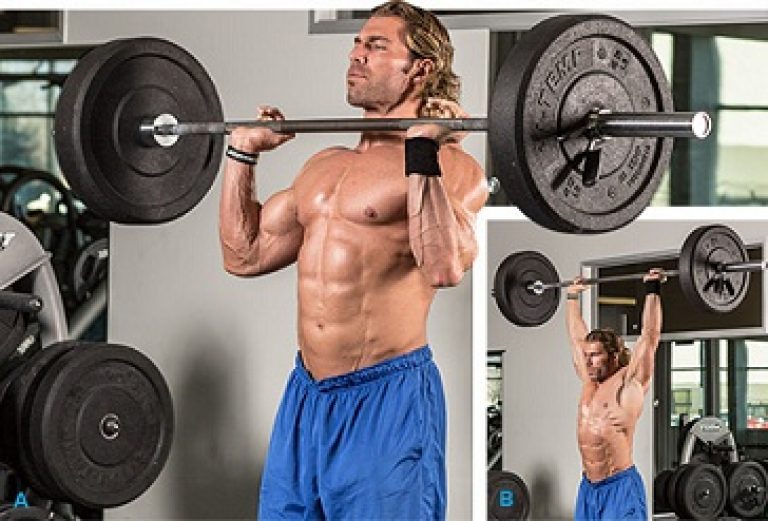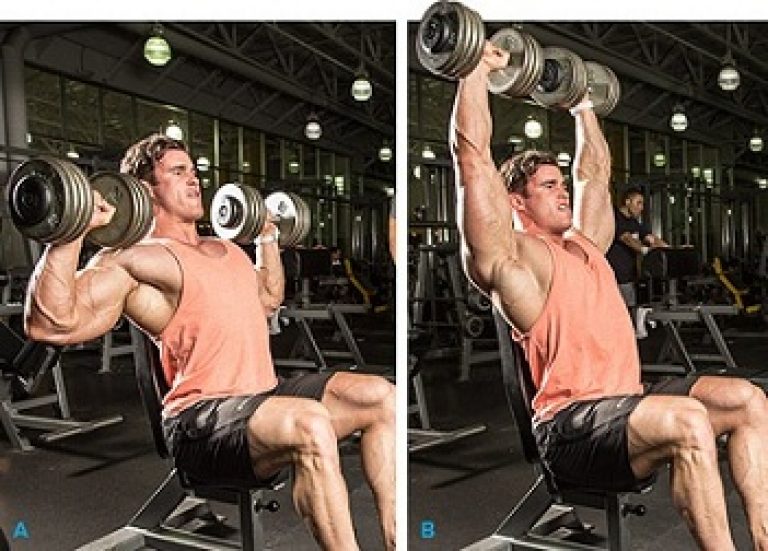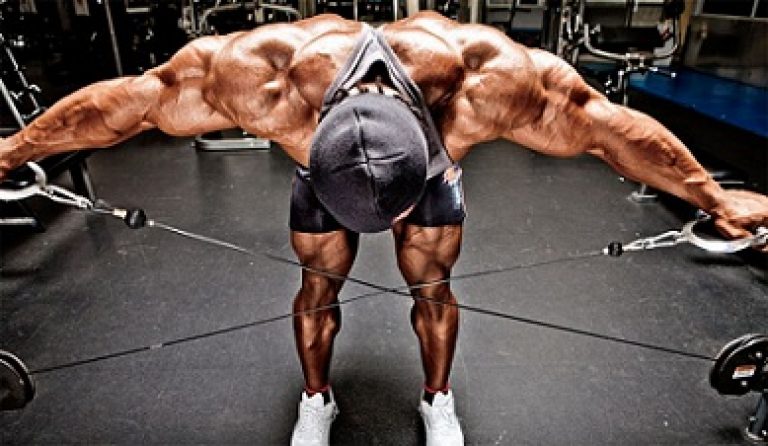Learn how to build broad shoulders as quickly as possible with minimal injury. Only proven advice from professionals!
Many gym goers use the rule, lift more and get more, these words have some truth, but they must be used wisely. Stupid weight lifting will give initial results, and then you will not get the long-awaited effect and your result will stall + you will earn an injury.
To do this, you need to connect your brains, use different training schemes, apply different degrees of load, and so on. Your attention is provided with 16 main rules for the proper development of the shoulders, with a minimum possibility of injury, remember them so that the training of the shoulders to the mass is successful.
1. It starts with the overhead press
Start working on the bench press while you are full of strength and energy, you can do it both with and with, it is better to alternate them, and not get hung up on one of them. This basic exercise perfectly works out all 3 parts of the deltas, and other muscles helpers, it is very important to work in the range of 6-12 repetitions, this is where muscle hypertrophy comes into action.
Do not try to do this exercise at the end of the workout, when the muscle fibers are working on the rest of the strength, raise the small one, and the muscles will work poorly.
2. Do seated and standing presses
 There is no fundamental difference between these 2 exercise options, but there is one significant difference.
There is no fundamental difference between these 2 exercise options, but there is one significant difference.
When done in a seated position, you work the shoulders more specifically, this is better for a more targeted pumping of the delts, but you can’t use the strength of the lower body. Therefore, you can overpower the weight, much less, and reduce the amount.
If you use the standing option, then this is called, here you can work with heavier weights and increase the number of repetitions, due to the fact that the initial impulse of movement comes from the lower body, including legs, abs, lower back. It is recommended to use it in heavy approaches so as not to damage the lower back. It is due to the fact that more weight is taken that more muscles are included in the work and there is an increase in the mass of not only the shoulders, but the whole body.
Alternate these exercises, this will give impetus to the development of large deltas.
3. Free weights come first
Always work with a barbell, dumbbell or kettlebell first, this is because in order to lift the weight many stabilizer muscles are involved in the work to keep the weight from swinging overhead. This requires fresh strength of the body and not tired muscles.
After this order, having exhausted your shoulders, you can switch to exercises in simulators in order to finish off the muscle fibers and get 100%.
4. Isolated exercises after basic
Many, due to the severity of the exercises, ignore the presses and start with, for example, this is where the big mistake lies. Isolated, single-joint exercises work specifically on a specific muscle area, but do not act as mass-gathering exercises completely for the shoulders.
These isolated exercises can be used at the end of a shoulder workout by using and.
5. Don't Forget the Chin Pull
10. Keep your shoulders evenly developed
 Uneven development of the shoulders, this is not only conspicuous and does not look beautiful, but can also cause injury to the rotator cuff of the deltas.
Uneven development of the shoulders, this is not only conspicuous and does not look beautiful, but can also cause injury to the rotator cuff of the deltas.
Guys who often train the chest, and do other exercises to develop it, have more front deltas than the side deltas. At the same time, they do not pay special attention to the bench press, because the main thing is to have a beautiful powerful chest.
Because of this, the shoulders look underdeveloped outwardly, the chest turns out to be large, and the shoulders are not wide enough. Dislike of traction exercises for the back, leaves the back section of the deltas out of work.
All this leads to weaknesses in the shoulder joints, which may not withstand the load of strength exercises, as other muscles grow and require more and more work.
The first exercise for the deltas is a bench press, and the second should go to the lagging part of the shoulder, and then to a more developed area.
11. When performing an isolated exercise, the elbows should not be unbent.
When the elbows are slightly bent, the load is directly concentrated in the shoulders, but as soon as they are straightened, part of the load will go to the triceps and the elbows will experience unnecessary tension. Therefore, choose adequate weights, based on the physical condition, do not violate the technique of movement and watch your elbows.
12. Protect your rotator cuff
It is responsible for the circular movements of the hands in the shoulders, so neglecting it can lead to negative consequences. Few people train her, but it doesn’t matter how much you pump or pump, it’s not visible, but her main task is not to show off outwardly, but to balance the shoulder joint.
Rotator cuff - consists of 4 muscles, always before training the shoulders, take small dumbbells in your hands and perform circular movements with your hands, slightly bending your arms at the elbows. Perform 10-15 rotations forward and then back, repeat 2-3 sets.
13. Respond immediately to pain
Sharp pain during exercise is bad pain and is nothing like after exercise. If it appears,  end the exercise immediately and move on to another, similar one.
end the exercise immediately and move on to another, similar one.
For example, replacing the barbell press with a dumbbell press puts the shoulders in a more natural position, does not break them out as much and is less traumatic, although it does not allow you to take such a large working weight.
At the first manifestation of pain, do not kill the muscles by clenching your teeth, immediately apply measures - massage, ointments, ice, otherwise doctors will treat you and severe inflammation of the shoulder cuff will leave you out of training for a long time.
14. Train your shoulders in a variety of ways
Shoulder mass training requires variety, don't get hung up on the same exercises and do not perform exercises with the same weight. As the muscles adapt to the load, they react less to it over time and muscle growth slows down.
Therefore, do different exercises, alternate load phases from heavy for 6 repetitions, to medium for 8-10 repetitions and light for 12-14 repetitions. Change the angles of inclination, body position, use dumbbells, barbells, simulators and crossovers, you can see the full list of exercises -.
15. Divide loads correctly
 You should not train the shoulders on the same day as the chest, the ideal option would be training with the legs, worse with the back.
You should not train the shoulders on the same day as the chest, the ideal option would be training with the legs, worse with the back.
With the bench press, the front delta receives the load, and when you immediately switch to shoulder training, it will already be tired, which will not make it possible to work with a good working weight and load the deltas well, especially the front one.
16. Don't Forget Trapezes
Many, in pursuit of perfect shoulders, forget the exercise for the development of trapezius muscles - and if they are trained, then after training the shoulders. It will be much more effective to train the trapezium after the back. Well-developed trapeziums will create a beautiful appearance of the body on a par with deltas.
